Welcome to our free classical music site

Do you write about classical music? Are you a blogger? Want to team up with Classical Connect? Send us a message, let's talk!

Do you write about classical music? Are you a blogger? Want to team up with Classical Connect? Send us a message, let's talk!
August 22, 2016. Debussy and Stockhausen. Claude Debussy, one of the greatest composers of the late 19th – early 20th century, was born in Saint-Germain-en-Laye, a suburb of Paris, on this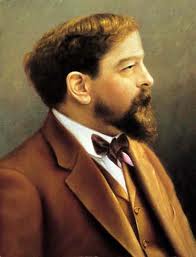 day in 1862. We’ve written about Debussy many times (here and here, for example) and usually illustrated his art with pieces written in the more popular genres – symphonic music and, especially, piano music. That somewhat skews the perspective: Debussy was prolific as a chamber composer, he wrote a large number of wonderful songs, and ever composed several operas, although he finished only one of them, Pelléas et Mélisande. Pelléas was written in 1902 on the libretto adapted from the namesake play by Maurice Maeterlinck. Debussy had toyed with the idea of writing an opera on several occasions. In 1890 he accepted a libretto written by a noted poet Catulle Mendès and started on the opera he called Rodrigue et Chimène. Debussy worked on it for the following three years, during which time his own compositional style had changed and he got dissatisfied both with his own music and with the libretto. Debussy abandoned Rodrigue after he saw a performance of Maeterlinck’s Pelléas. (The Opéra de Lyon asked Edison Denisov, the Russian composer blacklisted during the Soviet time, to complete the orchestration of the opera; Rodrigue was premiered in 1993, exactly 100 years after it was abandoned by Debussy). A short version of Pelléas was completed in 1895 but Debussy couldn’t find an opera theater that would commit to staging it. In 1898 André Messager, a composer, conductor and a friend of Debussy’, was made the music director of the Opéra-Comique in Paris. That lead to the premier on April 30th of 1902. The reaction was mixed. The public mostly disapproved, while musicians – friends of Debussy and most of the Conservatory students thought very highly of it. Camille Saint-Saëns, who disliked Debussy’s music in general said that he stayed in Paris, instead of leaving for a summer vacation, so that he could say “nasty things about Pelléas.” Here’s Act 3 of the opera (about 27 minutes of music); Claudio Abbado conducts the Vienna Philharmonic Orchestra, François Le Roux is Pelléas, Maria Ewing is Mélisande.
day in 1862. We’ve written about Debussy many times (here and here, for example) and usually illustrated his art with pieces written in the more popular genres – symphonic music and, especially, piano music. That somewhat skews the perspective: Debussy was prolific as a chamber composer, he wrote a large number of wonderful songs, and ever composed several operas, although he finished only one of them, Pelléas et Mélisande. Pelléas was written in 1902 on the libretto adapted from the namesake play by Maurice Maeterlinck. Debussy had toyed with the idea of writing an opera on several occasions. In 1890 he accepted a libretto written by a noted poet Catulle Mendès and started on the opera he called Rodrigue et Chimène. Debussy worked on it for the following three years, during which time his own compositional style had changed and he got dissatisfied both with his own music and with the libretto. Debussy abandoned Rodrigue after he saw a performance of Maeterlinck’s Pelléas. (The Opéra de Lyon asked Edison Denisov, the Russian composer blacklisted during the Soviet time, to complete the orchestration of the opera; Rodrigue was premiered in 1993, exactly 100 years after it was abandoned by Debussy). A short version of Pelléas was completed in 1895 but Debussy couldn’t find an opera theater that would commit to staging it. In 1898 André Messager, a composer, conductor and a friend of Debussy’, was made the music director of the Opéra-Comique in Paris. That lead to the premier on April 30th of 1902. The reaction was mixed. The public mostly disapproved, while musicians – friends of Debussy and most of the Conservatory students thought very highly of it. Camille Saint-Saëns, who disliked Debussy’s music in general said that he stayed in Paris, instead of leaving for a summer vacation, so that he could say “nasty things about Pelléas.” Here’s Act 3 of the opera (about 27 minutes of music); Claudio Abbado conducts the Vienna Philharmonic Orchestra, François Le Roux is Pelléas, Maria Ewing is Mélisande.
And now, as Monty Python would say, for something completely different. Karlheinz Stockhausen was also born on this day, in 1928. A seminal figure of the musical avant-garde of the after-WWII generation, he was praised by some and scorned by others (his electronic music Studie II received the lowest possible score of 1 from one of our listeners). Stockhausen was born in Burg Mödrath, near Cologne. When he was seven the family moved to Altenburg, nearby. His mother had a nervous breakdown and was institutionalized. In 1941 the family received an official letter informing them that she died of leukemia. It was determined later that she was gassed, as were most of the patients of the hospital, as a “useless eater” by the Nazis (Stockhausen will reinterpret this terrible episode in his opera Donnerstag aus Licht. Here’s the opening section of the opera. Karlheinz Stockhausen conducts the brass and percussion players). In 1947 he enrolled at the Cologne Musikhochschule (Conservatory), where he studied composition with Frank Martin. Upon graduating in 1951 he was invited to Darmstadt, the famous Ferienkurse für Neue Musik (Summer courses for new music). There he met several students of Olivier Messiaen and decided that he also needed to take his classes. He went to Paris in 1952, was accepted into Messiaen’s class and studied there for a year. Around that time a new Electronic Music Studio was established in Cologne and Stockhausen joined it in 1952. The new aural world was opening up.Permalink
August 15, 2016. Nicola Porpora. Nicola Porpora, a prolific opera composer, was born in Naples on August 17th of 1686. He was 10 when he enrolled in the Conservatorio dei Poveri di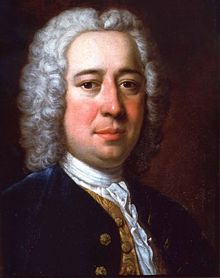 Gesù Cristo. In 1708 he received his first opera commission and wrote L’Agrippina but had to wait several years to get another one. That was probably because Alessandro Scarlatti so thoroughly dominated the Neapolitan opera scene: 1708 was the year the much more famous Scarlatti returned to Naples after six years in Florence and Rome. Porpora was 13 and still at the Conservatory when he started teaching and it’s his teaching talents that he would become famous for, at least as much as for his operas. As there were few opera commissions, he earned money working at the Conservatorio di S Onofrio and giving private lessons. In 1719 Scarlatti returned to Rome and that opened the stage for Porpora. One of the operas composed during that period was Angelica, on the libretto by the young Pietro Metastasio. The role of Orlando was sung by Porpora’s star pupil, the 15-year old castrato Farinelli, who would become one of the most celebrated singers in the history of opera. Among Porpora’s pupils was also Gaetano Majorano, known as Caffarelli, also a castrato, second only to Farinelli; he became one of Handel’s favorite singers. Here’s an aria from Angelica called Ombre amene. The countertenor is Robert Expert; the orchestra of Real Compañia Ópera De Cámara is conducted by Juan Bautista Otero.
Gesù Cristo. In 1708 he received his first opera commission and wrote L’Agrippina but had to wait several years to get another one. That was probably because Alessandro Scarlatti so thoroughly dominated the Neapolitan opera scene: 1708 was the year the much more famous Scarlatti returned to Naples after six years in Florence and Rome. Porpora was 13 and still at the Conservatory when he started teaching and it’s his teaching talents that he would become famous for, at least as much as for his operas. As there were few opera commissions, he earned money working at the Conservatorio di S Onofrio and giving private lessons. In 1719 Scarlatti returned to Rome and that opened the stage for Porpora. One of the operas composed during that period was Angelica, on the libretto by the young Pietro Metastasio. The role of Orlando was sung by Porpora’s star pupil, the 15-year old castrato Farinelli, who would become one of the most celebrated singers in the history of opera. Among Porpora’s pupils was also Gaetano Majorano, known as Caffarelli, also a castrato, second only to Farinelli; he became one of Handel’s favorite singers. Here’s an aria from Angelica called Ombre amene. The countertenor is Robert Expert; the orchestra of Real Compañia Ópera De Cámara is conducted by Juan Bautista Otero.
In 1723-24 Porpora traveled to Vienna and Munich but received no appointments. He returned to Italy and settled in Venice. An intense rivalry developed between him and Leonardo Vinci, who was Porpora’s classmate in Naples. In 1730 Porpora and Vinci produced operas which ran simultaneously in two leading Roman opera houses, one in Teatro della Dame, another – in Teatro Capranica (Teatro della Dame was the largest in Rome when built in 1718, it burned down in 1863; Teatro Capranica, the second oldest public opera house in Rome after the Teatro delle Quattro Fontane, still exists but is mostly used for various public events). In 1730 Vinci died, age 40, and for a while Poprora’s competitive impulse focused on another successful opera composer, Johann Adolph Hasse.
In 1733 Porpora received an invitation from a group of Londoners who were setting up an opera house to rival Handel’s. Porpora traveled to London and stayed there for almost three years. During that time he composed five operas, which were staged at the new opera, called Opera of the Nobility. The first, Arianna in Naxo, turned out to be the most successful one, even though Farinelli made his London debut in the subsequent Polifemo. Porpora left London in 1736, and less than a year later both the Opera of the Nobility and Handel’s opera collapsed. Here’s the wonderful French countertenor Philippe Jaroussky singing the area Alto Giove, from Polifemo. Porpora returned to Italy, splitting his time between Venice and Naples. The opera commissions were drying up, and Porpora traveled to Dresden, where he received an appointment as Kapellmeister at the court of Saxony. That lasted for five years; in 1752 he was sent into retirement and moved to Vienna. There he renewed his friendship with Metastasio; and it was probably Metastasio who introduced the 20-year old Joseph Haydn to Porpora. Haydn, who was trying to make a living as a freelancing pianist and composer, became Porpora’s valet, keyboard accompanist, and student. It seems Porpora treated Haydn pretty roughly, but Haydn later claimed that he learned "the true fundamentals of composition from the celebrated Herr Porpora.” Porpora was living mostly on a pension from Dresden, and when that ended in 1759, he moved back to Naples. He was made maestro di cappella in the Conservatorio di S Maria di Loreto. His final opera was a failure, he had to resign from the conservatory and spent the last years of his life in poverty. Porpora died in Naples on March 3rd of 1768. Here’s the aria Tu che d'ardir' m'accendi from his opera Siface. Again, we’ll hear Philippe Jaroussky, this time with Le Concert d'Astree under the direction of Emmanuelle Haim.Permalink
August 6, 2013. Dufay and the early Renaissance, part 2. Last week we discussed, in broad terms, the period of music that is customarily called “Early Renaissance.” Today we’ll present three famous composers of that period, Dufay, Dunstaple and Binchois. What we find fascinating in their stories is how intertwined the European music culture of the time was, on a personal level and with musical ideas spreading from one country to another. All this in a war-torn Europe, which often seems so static to a contemporary observer.
The most famous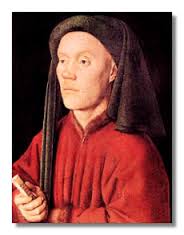 Franco-Flemish composer of the mid-15th century, Guillaume Dufay was probably born in 1397. Exactly where is not clear: either around Cambrai, in what is now Northern France, or in Beersel, outside of Brussels. He was an illegitimate child of a local priest. His uncle was a canon at the cathedral of Cambrai, and the young Guillaume became a chorister there. His talents were noticed early on and he was given formal musical training. In 1420 Dufay moved to Rimini to serve at the palace of Carlo Malatesta, a famous condottiero. There he wrote church music – masses and motets – and also secular ballades and rondeaux. Dufay stayed in Malatesta’s service till 1424 and then returned to France, to Cambrai or maybe Laon. In 1426 Dufay went back to Italy, this time into the service of Louis Aleman, a French Cardinal who at that time was a papal legate in Bologna. Two years later Dufay moved to Rome and became a member of the papal choir. He remained in Rome till 1433; by then his fame had spread all around Europe. He left Rome to join the court of Amédée VIII, the duke of Savoy. In 1434 the duke’s son Louis married Ann of Cyprus, and many guests were invited to the wedding. One of them wasPhilip the Good, duke of Burgundy. In the duke’s retinue was Gilles Binchois. Apparently Dufay and Binchois met on that occasion, at least according to Martin le Franc, the same le Franc who coined the term La Contenance Angloise to describe the style of John Dunstaple, another famous contemporary. In 1435 Dufay returned to the papal court, which this time was in Florence, where Pope Eugene IV was driven by an insurrection in Rome. It was in Florence that Dufay composed one of his most famous motets, Nuper Rosarum Flores ("Recently Flowers of Roses"). It was written for the consecration of the Florence cathedral, Santa Maria del Fiore (Saint Mary of the Flowers) on March 25th, 1436. The great architect Filippo Brunelleschi had just completed the magnificent cupola, and the Pope himself presided over the festivities. Dufay returned to Cambrai around 1459 and lived there for the rest of his life, actively composing till the end. His life was a long one, for the time: he died on November 24th of 1474.
Franco-Flemish composer of the mid-15th century, Guillaume Dufay was probably born in 1397. Exactly where is not clear: either around Cambrai, in what is now Northern France, or in Beersel, outside of Brussels. He was an illegitimate child of a local priest. His uncle was a canon at the cathedral of Cambrai, and the young Guillaume became a chorister there. His talents were noticed early on and he was given formal musical training. In 1420 Dufay moved to Rimini to serve at the palace of Carlo Malatesta, a famous condottiero. There he wrote church music – masses and motets – and also secular ballades and rondeaux. Dufay stayed in Malatesta’s service till 1424 and then returned to France, to Cambrai or maybe Laon. In 1426 Dufay went back to Italy, this time into the service of Louis Aleman, a French Cardinal who at that time was a papal legate in Bologna. Two years later Dufay moved to Rome and became a member of the papal choir. He remained in Rome till 1433; by then his fame had spread all around Europe. He left Rome to join the court of Amédée VIII, the duke of Savoy. In 1434 the duke’s son Louis married Ann of Cyprus, and many guests were invited to the wedding. One of them wasPhilip the Good, duke of Burgundy. In the duke’s retinue was Gilles Binchois. Apparently Dufay and Binchois met on that occasion, at least according to Martin le Franc, the same le Franc who coined the term La Contenance Angloise to describe the style of John Dunstaple, another famous contemporary. In 1435 Dufay returned to the papal court, which this time was in Florence, where Pope Eugene IV was driven by an insurrection in Rome. It was in Florence that Dufay composed one of his most famous motets, Nuper Rosarum Flores ("Recently Flowers of Roses"). It was written for the consecration of the Florence cathedral, Santa Maria del Fiore (Saint Mary of the Flowers) on March 25th, 1436. The great architect Filippo Brunelleschi had just completed the magnificent cupola, and the Pope himself presided over the festivities. Dufay returned to Cambrai around 1459 and lived there for the rest of his life, actively composing till the end. His life was a long one, for the time: he died on November 24th of 1474.
Gilles Binchois was born around 1400 in the city of Mons, which is now in Belgium and back then was the capital of the County of Hainaut. It later became part of the Duchy of Burgundy. During the Hundred Years’ War the Burgundians fought on the side of the English, and at some point even captured Paris. It’s known that around 1425 Binchois was in Paris serving William de la Pole, earl of Suffolk and one of the English commanders during the War. Around 1430 Binchois joined the court chapel of Philip the Good, the Duke of Burgundy and stayed there for many years. Philip loved music and hired many musicians and composers; Guillaume Dufay wrote for him. Philip didn’t have a permanent capital and moved his court between the palaces in Brussels, Bruges, Dijon and other cities of the Duchy; Binchois most likely traveled with the court. Eventually he retired to Soignies, just outside of Mons. He died in 1460. Binchois was considered the finest melodist of the 15th century (although some might argue that this honor belongs to John Dunstaple), and was, with Guillaume Dufay, the most significant composer of the early Burgundian (Franco-Flemish) School.
John Dunstaple was born around 1390 (a conjecture based on the timing of some compositions), probably in the town of Dunstable. He served in the court of John of Lancaster, a son of King Henry IV and a brother of Henry V. John led the British forces in many battles of the Hundred Year War with France (he was the one to capture Joan of Arc) and for a number of years was the Governor of Normandy. It’s likely that Dunstaple stayed with John in Normandy. From there his music spread around the continent. Considering that a major war was raging in France, it is quite remarkable. Dunstaple’s influence was significant, especially affecting musicians of the highly developed Burgundian school; the reason was both musical and political, as Burgundy was allied with England in its war against France. The poet Martin Le Franc, a contemporary of Dunstaple, came up with the term La Contenance Angloise, which could be loosely translated as “English manner” and said that it influenced the two greatest composers of Burgundy, Guillaume Dufay and Gilles Binchois. Le Franc wrote his treaties in 1442, by then Dunstaple was back in England, serving in the court of Humphrey of Lancaster, John’s brother. In addition to writing music, he also studied mathematics, and was an astronomer and astrologer. While not a cleric, he was associated with St. Albans Abbey. Dunstaple died in 1453. During the reign of Henry VIII England became Protestant, many monasteries – the main keepers of musical tradition – were "dissolved" and their libraries were ruined. Most of the English manuscripts of Dunstaple’s music were lost. Fortunately, many copies remained in Italy and Germany – evidence of Dunstaple’s international fame. About 50 compositions are currently attributed to him: two complete masses, a number of sections from masses that are otherwise lost, and many motets.
The portrait above, by Jan van Eyck from 1432of an unattributed sitter, is sometimes said to represent Dufay; other believe it to be Binchois.Permalink
August 1, 2016. Dufay and the early Renaissance, part 1. August 5th is sometimes associated with the name of Guillaume Dufay, one of the greatest composers of the early Renaissance. History recorded very few birth dates of composers of that period, and for the early Renaissance ones, even the year is usually speculative. In the case of Dufay, his birth date (August 5th of 1397) was “calculated” retroactively from some later events in his life by musicologists;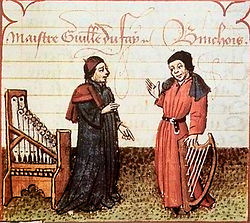 no direct record exists and other musicologists think it was sometime in 1400. So we write about composers of that era infrequently, even though they are very important in the forming of what we know as Western classical music.
no direct record exists and other musicologists think it was sometime in 1400. So we write about composers of that era infrequently, even though they are very important in the forming of what we know as Western classical music.
The notion of “Renaissance” was probably first consistently applied by Giorgio Vasari around 1550 in his book The Lives of Artists, even though two centuries earlier, in Decameron, Boccaccio talked about Giotto bringing light back to art that was dark for centuries. Still it was Vasari who clearly defined the break with the past, which he associated with two great Florentine painters, Giotto and Cimabue, who worked at the end of the 13th – beginning of the 14th centuries. The term itself wasnot popularized till the mid-19th century, first by the French historian Jules Michelet and then by Jacob Burckhardt, the Swiss historian of art and culture. For both of them “Renaissance” meant first and foremost visual arts and literature. For music, the term Renaissance had not been applied till the late 19th century, and even then rather vaguely and historically ill-defined. But if we look back we’ll see that as early as in the 15th century, the Franco-Flemish composer and music theorist Johannes Tinctoris had a sense that something had changed in the art of music. In his treaties called Proportionale he wrote around 1440: “At this time, consequently, the possibilities of our music has been so marvelously increased that there appears to be a new art, if I may so call it, whose found and origin is held to be among the English, of whom Dunstable stood forth as chief. Contemporary with him in France were Dufay and Binchois, to whom directly succeeded the modern Ockeghem, Busnois, Regis and Caron, who are the most excellent of all the composers I’ve ever heard.” Even though in this passage Tinctoris doesn’t mention Guillaume Dufay, we know that he had enormous respect for him (which should be expected, as Tinctoris was Dufay’s student at the cathedral of Cambrai). From this paragraph, and also from the writings of the musicologists of the 19th and the 20th centuries, we can see that the Renaissance in music started somewhere between 1400 and 1430, more than 100 later than the Italian Renaissance in arts and literature.
The music of the early Renaissance is usually associated with Burgundy. In the early 15th century, the Duchy of Burgundy was probably the most stable and prosperous state in Europe. Led by the Valois branch of the royal family, closely related to the French kings, it acquired many principalities of what is now Belgium and the Netherlands: Flanders, Brabant, Hainault, also the Duchy of Luxemburg and many others. While France was ravaged by the Hundred Years' War, which started in 1337 and lasted till 1453, Burgundy prospered. Before the war, Paris was the cultural center, as was Avignon (wherethe Popes temporarily moved from Rome), but by the early 15th century the center migrated to Burgundy. The Dukes were not just patrons of music, they actively participated in music-making. Burgundy was unusual in that the Dukes liked to move from one city to another, and the court, with all the musicians and artists, moved with them. Dijon wasthe administrative center of the state, but Brussels, Bruges and other larger cities of the Low Countries thus benefitted from its cultural riches.
Another event that tremendously benefitted the development of music was the invention, by Johannes Gutenberg, of the movable print in 1450. Though first it was used to print books (the Bible first and foremost) very soon it was applied to the music publishing business. Before Gutenberg, music was copied by hand, usually by monks. Using the movable press, printed music became cheaper, copies more numerous, and new musical ideas could be disseminated all over Europe.
We’ll continue with several individual composers of the period in the next post. The miniature above is from a page of a manuscript of Martin le Franc shows Dufay (on the left) and Binchois.Permalink
July 24, 2016. Minor notables. Ernest Bloch, a Swiss-American composer, was born this day in 1880 in Geneva. He went to Brussels to study violin with Eugène Ysaÿe. He began composing at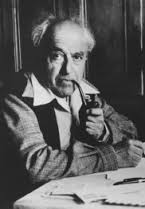 the age of nine, and took formal classes in Frankfurt in 1900. He moved to Paris and then back to Geneva where he married and joined his father’s business as a bookkeeper and salesman. He continued to compose, sporadically, kept up his musical connection and in 1916 went on a tour of the United States with a dance company as a conductor. The tour was a failure but Bloch was offered a position at the newly organized David Mannes College of Music in New York. Around that time he composed what would become his best known composition, Schelomo, Rhapsodie Hébraïque for Cello and Orchestra, the final work of his “Jewish cycle” (Bloch was Jewish). It was well received and remains popular to this day. In 1920 he became the founding director of the Cleveland Institute of Music, where he served for five years. In 1925 he moved to San Francisco to lead the local conservatory. In the 1930s Bloch lived mostly in Switzerland but returned to the US in 1940. He taught at Berkeley and continued to compose. Bloch died on July 15th of 1959. Here’s a recording of Schelomo made by Mstislav Rostropovich in 1977. Leonard Bernstein is leading the Orchestre National De France.
the age of nine, and took formal classes in Frankfurt in 1900. He moved to Paris and then back to Geneva where he married and joined his father’s business as a bookkeeper and salesman. He continued to compose, sporadically, kept up his musical connection and in 1916 went on a tour of the United States with a dance company as a conductor. The tour was a failure but Bloch was offered a position at the newly organized David Mannes College of Music in New York. Around that time he composed what would become his best known composition, Schelomo, Rhapsodie Hébraïque for Cello and Orchestra, the final work of his “Jewish cycle” (Bloch was Jewish). It was well received and remains popular to this day. In 1920 he became the founding director of the Cleveland Institute of Music, where he served for five years. In 1925 he moved to San Francisco to lead the local conservatory. In the 1930s Bloch lived mostly in Switzerland but returned to the US in 1940. He taught at Berkeley and continued to compose. Bloch died on July 15th of 1959. Here’s a recording of Schelomo made by Mstislav Rostropovich in 1977. Leonard Bernstein is leading the Orchestre National De France.
John Field, Irish composer and pianist, was born on July 26th of 1782. The “father” of the Nocturne, and in that Chopin’s precursor (on a much smaller scale), Field moved to London to study with Muzio Clementi. He soon became famous as a young virtuoso; Haydn, during one of his trips in London, heard him play and praised him in his notebook: “Field a young boy, which plays the piano extremely well.” In 1802 Field followed his teacher Clementi to Russia. Clementi, a composer and a pedagogue, was also in the piano business, and used Field to demonstrate pianos to potential customers. Clementi left Russia in 1803 but Field stayed behind. He played numerous concerts, first in St.-Petersburg and then in the Baltics and Moscow. In 1806 he moved to Moscow and lived there for five years, eventually returning to St.Petersburg. Popular not just as a concert pianist but as a private tutor, he became the most expensive piano teacher in Russia. In 1810 he married one of his pupils, a French actress and pianist named Adelaide Percheron. The 1810s was a productive period when he wrote most of his nocturnes. They would later be much admired by Chopin and Liszt. The feeling was not reciprocal, as Field was critical of both. Field stayed in Russia till 1831 when he went to London for an operation: he had rectal cancer. After the operation, he unsuccessfully tried to resurrect his pianistic career. He ended up in a hospital in Naples, penniless, and had to be rescued by his Russian friends who brought him back to Moscow. There he died on January 23rd of 1837. Here’s John O’Connor playing Field’s Nocturne no. 5 in B-flat Major.
If Field was famous for his piano music,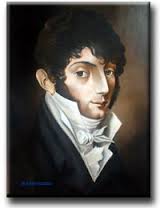 who was born one year earlier, on July 27th of 1781, became famous for his music for the guitar. The early 19th century, the time Giuliani was growing up, was aperiod of deep decline in classical music in Italy. The only musical form that was flourishing was the opera. So, as many of his compatriots, the young Giuliani moved up north and settled in Vienna. Even though his first instrument was the cello, he became famous as the greatest guitar virtuoso, acknowledged by musicians and the court. He was one of the first to compose and perform a concerto for the guitar and symphony orchestra. He became acquainted with all of the prominent musician of Vienna, starting with Beethoven. He performed chamber concerts with the best local musicians, and composed, mostly for the guitar. In 1819 he returned to Italy, first to Rome and then to Naples. That’s where he died, on May 8th of 1829, just 47 years old. Here’s his Prelude op.83 no. 2, performed by Dmitry Teslov.Permalink
who was born one year earlier, on July 27th of 1781, became famous for his music for the guitar. The early 19th century, the time Giuliani was growing up, was aperiod of deep decline in classical music in Italy. The only musical form that was flourishing was the opera. So, as many of his compatriots, the young Giuliani moved up north and settled in Vienna. Even though his first instrument was the cello, he became famous as the greatest guitar virtuoso, acknowledged by musicians and the court. He was one of the first to compose and perform a concerto for the guitar and symphony orchestra. He became acquainted with all of the prominent musician of Vienna, starting with Beethoven. He performed chamber concerts with the best local musicians, and composed, mostly for the guitar. In 1819 he returned to Italy, first to Rome and then to Naples. That’s where he died, on May 8th of 1829, just 47 years old. Here’s his Prelude op.83 no. 2, performed by Dmitry Teslov.Permalink
July 18, 2016. Beethoven Symphony No. 6. Today we’ll present an article by Joseph DuBose on one of the most popular symphonic pieces in all of music literature: Beethoven’s Sixth Symphony (“Pastoral”). The problem we encountered was with the selection of the recording to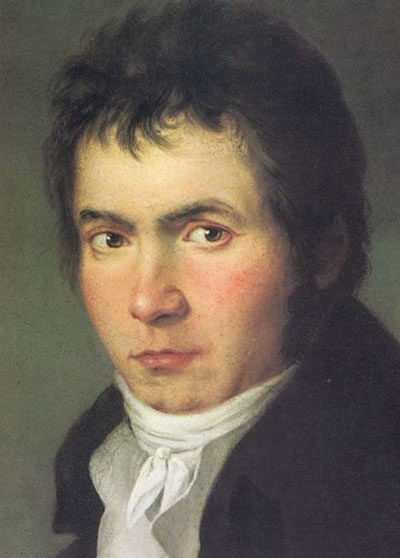 illustrate the article: there are just too many good ones. The “Pastoral” is one of the most often recorded symphonies, and great recordings go back to the early years of the industry. To list them would be to list the names of all great conductors of the 20th century. We decided on the live recording made by the Concertgebouw Orchestra under the direction of Bernard Haitink. We don’t claim that it’s the best but it is indeed excellent. Here it is. ♫
illustrate the article: there are just too many good ones. The “Pastoral” is one of the most often recorded symphonies, and great recordings go back to the early years of the industry. To list them would be to list the names of all great conductors of the 20th century. We decided on the live recording made by the Concertgebouw Orchestra under the direction of Bernard Haitink. We don’t claim that it’s the best but it is indeed excellent. Here it is. ♫
Each of Beethoven’s symphonic works up to the C minor Symphony represent individual steps in the determined path the composer set out on. In the first two, he adhered to the models of Mozart and Haydn, but only just so. His creative genius was already pushing out against the established manners and proportions of the symphony. The Eroica left behind all that was known and was the first significant work on the “new path” Beethoven declared in 1802. The B-flat Symphony which soon after followed, in outward appearance at least, may seem like a regression from the Eroica. Yet, even if it is stricter in form than its predecessor, the same passionate emotions pulse beneath its surface. The C minor, then, is the fusion of both works—that taut forms of the Fourth combined with the seriousness and heroism of the Eroica. However, with the Sixth Symphony, or the “Pastoral” as it is so often called, Beethoven presents us with a work entirely different from its any of its predecessors. That it came to birth alongside the fiery C minor is remarkable indeed. It is a startling revelation of the great breadth of the composer’s imagination, that he could conceive so vastly different works at the same time.
The “Pastoral” Symphony is Beethoven’s homage to nature. For him, nature was an absolute necessity—for life and for creative endeavors. He spent the better part of his summers wandering the wooded countrysides of Hetzendorf, Heiligenstadt, and Döbling. It was in these rustic environs that he conceived and drafted many of his greatest compositions, which were then completed and put into score during his winters in Vienna.
From a historical perspective, the Sixth Symphony was the first truly successful example of “program music,” and laid the groundwork for the concert overtures of Mendelssohn and the symphonic poems of Liszt. Yet, contrary to those later masters (Liszt in particular), Beethoven recognizes the limitations of music as an artistic medium. Though he has provided subtitles for each individual movement that succinctly describe the picture being painted by the music, he provides the crucial key to his intent beneath the work’s title: “More an expression of feeling than a painting.” Indeed, it is apparent in the conception of the symphony that Beethoven was quick to avoid any instance of actual imitations of sights or sound. Indeed, even the celebrated imitations of birdcalls towards the conclusion of the second movement Beethoven has admitted were intended as a practical joke, and the section as a whole is more in keeping with the capricious outbursts found in his other symphonies than any attempt at blatant tone-painting. (Continue reading here).Permalink